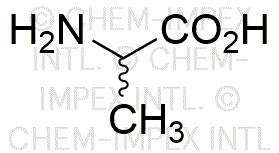DL-Alanine is widely utilized in research focused on:
- Amino Acid Supplementation: Commonly used in dietary supplements to support muscle recovery and growth, making it popular among athletes and fitness enthusiasts.
- Pharmaceutical Formulations: Serves as an excipient in drug formulations, enhancing the stability and solubility of active pharmaceutical ingredients.
- Food Industry: Acts as a flavor enhancer and is used in food products to improve taste and nutritional value, particularly in protein-rich foods.
- Biochemical Research: Essential in studies involving protein synthesis and metabolism, helping researchers understand cellular processes and disease mechanisms.
- Cosmetic Products: Incorporated in skincare formulations for its moisturizing properties, contributing to the hydration and smoothness of the skin.
General Information
Properties
Safety and Regulations
Applications
DL-Alanine is widely utilized in research focused on:
- Amino Acid Supplementation: Commonly used in dietary supplements to support muscle recovery and growth, making it popular among athletes and fitness enthusiasts.
- Pharmaceutical Formulations: Serves as an excipient in drug formulations, enhancing the stability and solubility of active pharmaceutical ingredients.
- Food Industry: Acts as a flavor enhancer and is used in food products to improve taste and nutritional value, particularly in protein-rich foods.
- Biochemical Research: Essential in studies involving protein synthesis and metabolism, helping researchers understand cellular processes and disease mechanisms.
- Cosmetic Products: Incorporated in skincare formulations for its moisturizing properties, contributing to the hydration and smoothness of the skin.
Documents
Safety Data Sheets (SDS)
The SDS provides comprehensive safety information on handling, storage, and disposal of the product.
Product Specification (PS)
The PS provides a comprehensive breakdown of the product’s properties, including chemical composition, physical state, purity, and storage requirements. It also details acceptable quality ranges and the product's intended applications.
Certificates of Analysis (COA)
Search for Certificates of Analysis (COA) by entering the products Lot Number. Lot and Batch Numbers can be found on a product’s label following the words ‘Lot’ or ‘Batch’.
*Catalog Number
*Lot Number
Certificates Of Origin (COO)
This COO confirms the country where the product was manufactured, and also details the materials and components used in it and whether it is derived from natural, synthetic, or other specific sources. This certificate may be required for customs, trade, and regulatory compliance.
*Catalog Number
*Lot Number
Safety Data Sheets (SDS)
The SDS provides comprehensive safety information on handling, storage, and disposal of the product.
DownloadProduct Specification (PS)
The PS provides a comprehensive breakdown of the product’s properties, including chemical composition, physical state, purity, and storage requirements. It also details acceptable quality ranges and the product's intended applications.
DownloadCertificates of Analysis (COA)
Search for Certificates of Analysis (COA) by entering the products Lot Number. Lot and Batch Numbers can be found on a product’s label following the words ‘Lot’ or ‘Batch’.
*Catalog Number
*Lot Number
Certificates Of Origin (COO)
This COO confirms the country where the product was manufactured, and also details the materials and components used in it and whether it is derived from natural, synthetic, or other specific sources. This certificate may be required for customs, trade, and regulatory compliance.


